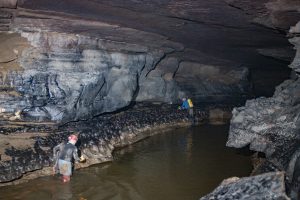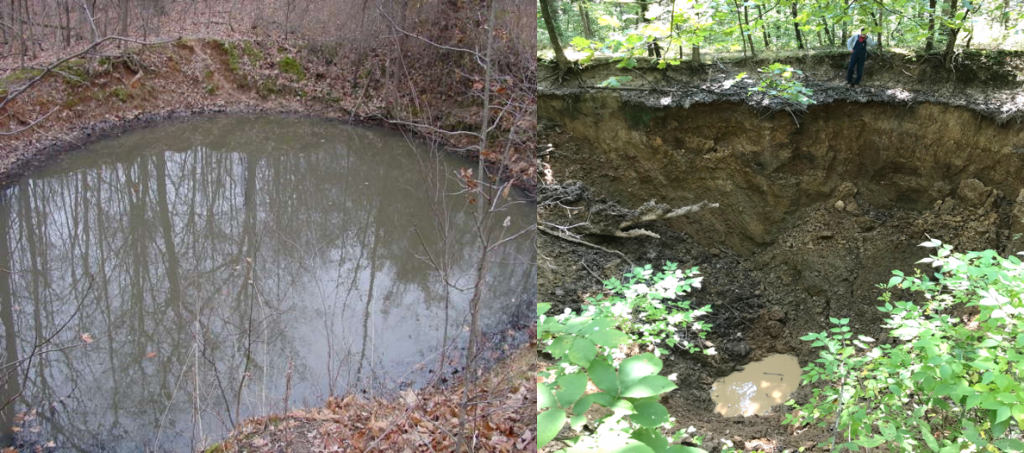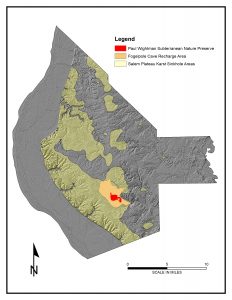2021: The International Year of Caves and Karst
By Bob Weck, Professor of Biology at SWIC and Clifftop board member
“International years” celebrate and inform the world about important topics, many of which are not known to the general public. 2021 is The International Year of Caves and Karst, organized by the International Union of Speleology, the worldwide organization of cave and karst explorers, scientists, managers, and educators (http://iyck2021.org/ ). Caves and karst geology occur around our planet but few people understand the nature of karst or the great value of caves to humanity.

The term karst refers to a landscape with features like caves, sinkholes, and springs that develop through dissolution and erosion of limestone bedrock. More than 25 percent of the world’s population either lives on or obtains its water from karst aquifers. According to the US Geological Survey, approximately 20 percent of the land surface in the United States is karst and roughly 20 percent of all groundwater withdrawals in the year 2000 came from karst aquifers. Approximately 9% of Illinois is karst. Monroe County has the most intense karst topography in the state.

Caves are important ecosystems for several reasons. Cave formations like stalactites and sediments deposited in caves long ago contain records of our climatic past that can provide valuable information about climate change. Caves can also preserve archeological material that help us reconstruct human history and fossils that inform us about plant and animal life on Earth. Many rare animals are adapted to the total darkness and low nutrient conditions in caves. According to a 2018 summary by the Illinois Speleological Survey, more than 300 caves are reported from southwestern Illinois, with 75% of the caves occurring in Monroe County. Many of these caves are small “bellycrawls”, but a few large caves are found in the area. Unfortunately, an invasive fungus causing “White Nose Syndrome” has decimated several species of cave-dwelling bats in the United States. Our local bats are all insect eaters and help control many pest insects like mosquitoes, corn earworm moths, and rootworm moths. Concern about bats and White Nose Syndrome caused the closure of Illinois Caverns near Waterloo in 2010. Illinois Caverns is owned by the Illinois Department of Natural Resources and was a popular site with folks seeking a caving adventure.

Sinkholes are the most obvious karst landscape feature in southwestern Illinois. Using GIS tools and LIDAR (Light Detection and Ranging) images, over 15,000 sinkholes have been mapped in the area of Monroe, Randolph, and St. Clair Counties known as the Sinkhole Plain. Monroe County recently launched an interactive map showing sinkhole distribution in the county. The Sinkholes and Soil Types map can be found on the Featured Maps & Apps page of the County’s website (https://monroecountyil.maps.arcgis.com/home/index.html). These depressions form in places where the thick layer of loess soil erodes into crevices and caves in the limestone bedrock, creating voids in the soil that eventually collapse. While sinkholes can be serious hazards to human-built structures, they do have important biological and geological functions in a karst landscape. Sinkholes represent conduits that allow surface water to enter and recharge the aquafers and feed cave streams. Some sinkholes plug with soil and hold water, creating semi-permanent ponds. Sinkhole ponds are important habitat for amphibians, dragonflies, waterfowl, and scores of other aquatic creatures. Although a sinkhole pond may support a lively sport fishery, fishless ponds have greater ecological benefits as amphibian breeding sites.

Winter is a great time to see many karst features as the lack of vegetation provides a less obstructed view of surface topography. Two local natural areas offer hikers an abundance of karst features on display. A visit to Clifftop’s Paul Wightman Subterranean Nature Preserve, 3325 G Road, Fults, provides a chance to hike on well-maintained trails that traverse the landscape above a portion of Fogelpole Cave and learn about karst from the excellent interpretive signs. With over 15 miles of mapped passage, Fogelpole is currently ranked the 54th longest cave in the United States and is Illinois’ largest and most biodiverse cave with at least 15 totally cave adapted invertebrate species present. Later in spring, visitors will hear the calls of several frog species that breed in the sinkhole ponds that dot the preserve. Stemler Cave Woods Nature Preserve, located off Stemler Road in Columbia, is owned by the Illinois Department of Natural Resources. The preserve has over two miles of trails that meander through a mostly wooded karst landscape that features numerous large sinkholes. During the summer of 2020, a pond in Stemler Cave Woods NP, that has held water for at least 20 years, drained in a sudden and dramatic display of how dynamic karst topography can be, revealing a very deep sinkhole. Care should be taken when visiting either preserve to stay on marked trails and obey posted rules and precautions.
Here is list of websites you can visit to learn more about caves and karst:
http://iyck2021.org/ International Year of Caves and Karst
https://caves.org/ National Speleological Society
http://www.meramecvalleygrotto.org/ Meramec Valley Grotto, a local caving club
https://ilspeleo.org/ Illinois Speleological Survey, a nonprofit group dedicated to cave research
https://karstwaters.org/ Karst Waters Institute, a nonprofit organization
https://www.youtube.com/watch?v=bO-sYCfcXYI A presentation about cave and karst management in Illinois
CLIFFTOP, a local nonprofit organization, is focused on preserving and protecting area bluff lands.
A version of this article appeared in the February 19, 2021 edition of the Monroe County Independent.
©2021 all content rights reserved Clifftop NFP
Comments are currently closed.
